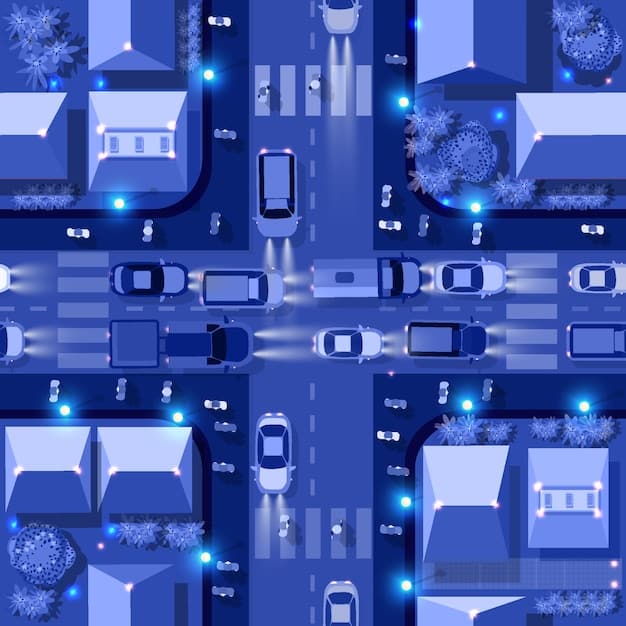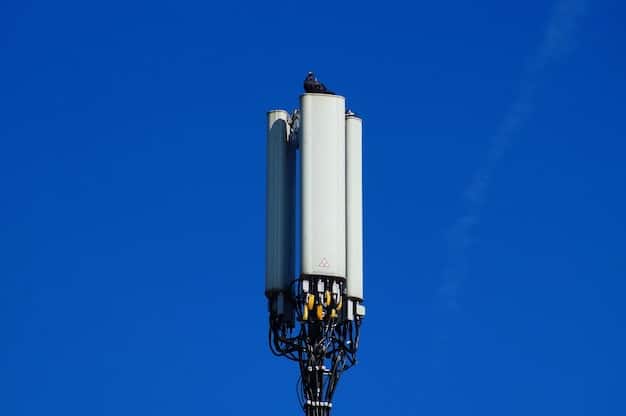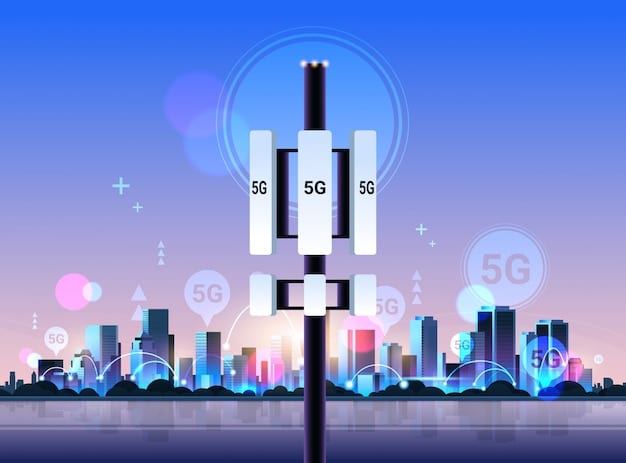5G Expansion and Autonomous Vehicles: US Development by 2026

The expansion of 5G networks across the US is poised to revolutionize autonomous vehicle development by 2026, offering faster data transmission, lower latency, and increased bandwidth necessary for real-time decision-making and enhanced safety features in self-driving cars.
How will the nationwide rollout of 5G technology impact the future of self-driving cars? The answer lies in the transformative capabilities of 5G to enhance connectivity and enable the real-time data processing required for safe and efficient autonomous vehicle (AV) operation. Let’s explore how will the expansion of 5G networks across the US affect the development of autonomous vehicles by 2026.
The Current State of Autonomous Vehicle Technology
The autonomous vehicle industry is currently undergoing rapid advancements, with companies like Tesla, Waymo, and Ford investing heavily in research and development. However, current AV technology relies on a combination of sensors, cameras, and radar, which can be limited by processing power and network connectivity. This is where 5G comes into play.
Limitations of Current Technology
Existing AV technology often faces challenges in densely populated urban areas where network congestion can lead to latency issues. Additionally, the computational requirements for processing real-time data from various sensors can strain on-board systems, limiting the AV’s ability to react quickly and safely.
The Need for Speed and Reliability
For autonomous vehicles to operate safely and efficiently, they require instantaneous data transmission and ultra-reliable network connectivity. This is particularly crucial in situations that demand split-second decision-making, such as emergency braking or collision avoidance. The low latency and high bandwidth of 5G can address these critical needs.
- Enhanced Sensor Data Processing: 5G enables faster processing of sensor data, improving the AV’s perception of its surroundings.
- Real-Time Navigation Updates: AVs can receive real-time traffic and navigation updates, optimizing routes and reducing congestion.
- Improved Vehicle-to-Everything (V2X) Communication: 5G facilitates seamless communication between vehicles, infrastructure, and other road users, enhancing safety and coordination.
In conclusion, the current limitations of AV technology highlight the critical need for a robust and reliable network infrastructure like 5G to unlock the full potential of autonomous driving.

How 5G Enhances Autonomous Vehicle Capabilities
5G networks offer several key advantages that can significantly enhance the capabilities of autonomous vehicles. These include increased data transmission speeds, reduced latency, and higher bandwidth, all of which are essential for real-time data processing and enhanced safety features.
Increased Data Transmission Speeds
5G’s significantly higher data transmission speeds compared to 4G LTE allow AVs to process larger volumes of data more quickly. This enables the AV to analyze information from sensors, cameras, and radar in real-time, improving its ability to detect and respond to potential hazards.
Reduced Latency
One of the most critical advantages of 5G is its ultra-low latency, which refers to the time it takes for data to be transmitted and processed. Lower latency is crucial for autonomous vehicles because it reduces the delay between detecting a hazard and initiating a response, such as braking or steering. The reduced latency is required for avoiding accidents.
Higher Bandwidth
5G’s higher bandwidth allows AVs to connect to a greater number of devices and systems without experiencing performance degradation. This is particularly important in densely populated areas where multiple AVs may need to communicate with each other and with the surrounding infrastructure.
- Remote Monitoring and Control: 5G enables remote monitoring and control of AVs, allowing human operators to intervene in situations where the AV is unable to handle a situation independently.
- Over-the-Air (OTA) Updates: AVs can receive OTA software updates via 5G, ensuring they always have the latest features and security patches.
- Enhanced Cybersecurity: 5G networks incorporate advanced security features that protect AVs from cyberattacks and unauthorized access.
In summary, 5G’s increased data transmission speeds, reduced latency, and higher bandwidth are poised to enable a new generation of autonomous vehicles with enhanced safety, efficiency, and capabilities.
The Infrastructure Requirements for 5G-Enabled AVs
For 5G to fully support the development of autonomous vehicles, significant investments in infrastructure are required. This includes the deployment of 5G base stations, the installation of edge computing facilities, and the integration of 5G with existing transportation infrastructure.
Deployment of 5G Base Stations
To provide ubiquitous 5G coverage, a dense network of 5G base stations must be deployed across the US. This requires significant investments in hardware, software, and installation services and skilled labor.
Installation of Edge Computing Facilities
Edge computing facilities are strategically located data centers that bring computational power closer to the edge of the network, reducing latency and improving the responsiveness of AVs. These facilities are critical for processing real-time data from AV sensors and cameras.
Integration with Existing Transportation Infrastructure
Integrating 5G with existing transportation infrastructure, such as traffic lights, road signs, and highway systems, is essential for enabling V2X communication and enhancing overall transportation efficiency. This requires collaboration between telecommunications companies, transportation agencies, and automotive manufacturers.
- Smart City Initiatives: The deployment of 5G-enabled AVs is closely linked to smart city initiatives that aim to improve urban living.
- Government Regulations and Policies: Government regulations and policies play a critical role in shaping the development and deployment of 5G and AV technologies.
- Public-Private Partnerships: Public-private partnerships are essential for accelerating the deployment of 5G infrastructure and supporting the development of AV technology.
In conclusion, the successful deployment of 5G-enabled AVs requires a concerted effort to address the infrastructure requirements, including the deployment of 5G base stations, the installation of edge computing facilities, and the integration of 5G with existing transportation infrastructure.

Challenges and Obstacles to 5G-AV Integration
While the potential benefits of integrating 5G with autonomous vehicles are significant, several challenges and obstacles need to be addressed. These include regulatory hurdles, cybersecurity risks, and the digital divide.
Regulatory Hurdles
The deployment of 5G and AV technologies is subject to a complex web of federal, state, and local regulations. Navigating these regulations can be time-consuming and costly, potentially delaying the deployment of 5G-enabled AVs. Clear and consistent regulations are necessary.
Cybersecurity Risks
As AVs become increasingly connected, they become more vulnerable to cyberattacks. Protecting AVs from unauthorized access and ensuring the security of 5G networks are critical concerns that must be addressed through robust cybersecurity measures.
The Digital Divide
The digital divide, which refers to the gap between those who have access to digital technologies and those who do not, poses a significant challenge to the widespread deployment of 5G-enabled AVs. Ensuring equitable access to 5G connectivity is essential for realizing the full potential of AV technology.
- Data Privacy Concerns: The collection and use of data by AVs raise data privacy concerns that need to be addressed through appropriate safeguards and regulations.
- Public Acceptance and Trust: Public acceptance and trust are essential for the successful deployment of AV technology.
- Ethical Considerations: The development and deployment of AVs raise ethical considerations, such as how AVs should be programmed to respond in emergency situations.
In summary, overcoming the challenges and obstacles to 5G-AV integration, including regulatory hurdles, cybersecurity risks, and the digital divide, is essential for realizing the full potential of autonomous vehicle technology.
The Economic Impact of 5G-Enabled AVs
The widespread deployment of 5G-enabled AVs is expected to have a significant economic impact, creating new jobs, stimulating economic growth, and transforming various industries. The adoption of autonomous vehicles will change our view of transportation.
Job Creation
The development, deployment, and maintenance of 5G-enabled AVs will create new jobs in various sectors, including telecommunications, automotive manufacturing, software development, and transportation services. Job creation will be impacted by AV technology.
Economic Growth
The increased efficiency, productivity, and safety enabled by 5G-enabled AVs will stimulate economic growth by reducing transportation costs, improving supply chain logistics, and enhancing overall business operations leading to the development of the economy.
Industry Transformation
5G-enabled AVs have the potential to transform various industries, including transportation, logistics, delivery services, and urban planning. The changes will affect almost every facet of our lives.
- Increased Productivity: AVs can operate 24/7, increasing productivity and reducing downtime for businesses.
- Reduced Congestion: AVs can optimize traffic flow and reduce congestion, saving time and money for commuters and businesses.
- Enhanced Safety: AVs can reduce accidents and improve road safety, saving lives and reducing healthcare costs.
In conclusion, the economic impact of 5G-enabled AVs is expected to be significant, with the potential to create new jobs, stimulate economic growth, and transform various industries.
Future Trends in 5G and Autonomous Vehicle Technology
The future of 5G and autonomous vehicle technology is constantly evolving, with several key trends expected to shape the industry in the coming years. The trends will shape the ways we work, live, and play.
Advancements in AI and Machine Learning
Advancements in artificial intelligence (AI) and machine learning (ML) will enable AVs to make more intelligent decisions and adapt to changing driving conditions. This will make AVs more safe.
Edge Computing Expansion
The expansion of edge computing infrastructure will further reduce latency and improve the responsiveness of AVs, enhancing their overall performance. This would result in faster response times by smart vehicles.
Integration with Smart City Ecosystems
The integration of 5G-enabled AVs with smart city ecosystems will enable seamless communication and coordination between vehicles, infrastructure, and other urban systems, leading to more efficient and sustainable transportation.
- Standardization of V2X Communication: The standardization of V2X communication protocols will enable interoperability between different AV models and manufacturers.
- Increased Cybersecurity Focus: The industry will place an increased focus on cybersecurity to protect AVs from cyberattacks.
- Development of New Business Models: New business models, such as mobility-as-a-service (MaaS), will emerge to take advantage of the capabilities of 5G-enabled AVs.
In conclusion, the future trends in 5G and autonomous vehicle technology, including advancements in AI and ML, edge computing expansion, and integration with smart city ecosystems, are poised to revolutionize the way we travel and interact with our environment.
| Key Point | Brief Description |
|---|---|
| 🚀 Enhanced Connectivity | 5G offers faster data and lower latency, critical for autonomous vehicle operation. |
| 🛡️ Cybersecurity Challenges | Protecting autonomous vehicles from cyber threats is a major concern. |
| 💰 Economic Impact | 5G-enabled AVs can boost job creation and transform industries. |
| 🌐 Infrastructure Needs | Extensive 5G deployment and edge computing are crucial for AV success. |
Frequently Asked Questions (FAQ)
▼
5G is the fifth generation of wireless technology, offering faster speeds and lower latency. It provides crucial connectivity for real-time data processing and enhanced safety features in autonomous vehicles, making driving safer.
▼
The main requirements include a dense network of 5G base stations, edge computing facilities for low-latency processing, and integration with existing transportation infrastructure like traffic lights and road sensors.
▼
Challenges include regulatory hurdles, cybersecurity risks, and the digital divide, which could limit equitable access to 5G connectivity and hinder widespread deployment of autonomous vehicle technology making it unsafe.
▼
5G-enabled autonomous vehicles are expected to stimulate economic growth by creating new jobs in sectors like telecommunications and automotive manufacturing, and by transforming industries like logistics and transportation.
▼
Future trends include advancements in AI and machine learning for improved decision-making, expansion of edge computing to reduce latency, and integration with smart city ecosystems for seamless communication and efficient urban transportation.
Conclusion
In conclusion, the expansion of 5G networks across the US has the potential to revolutionize the development of autonomous vehicles by 2026. While there are challenges to overcome, the benefits of increased connectivity, reduced latency, and enhanced safety make 5G a critical enabler for the future of autonomous driving.





